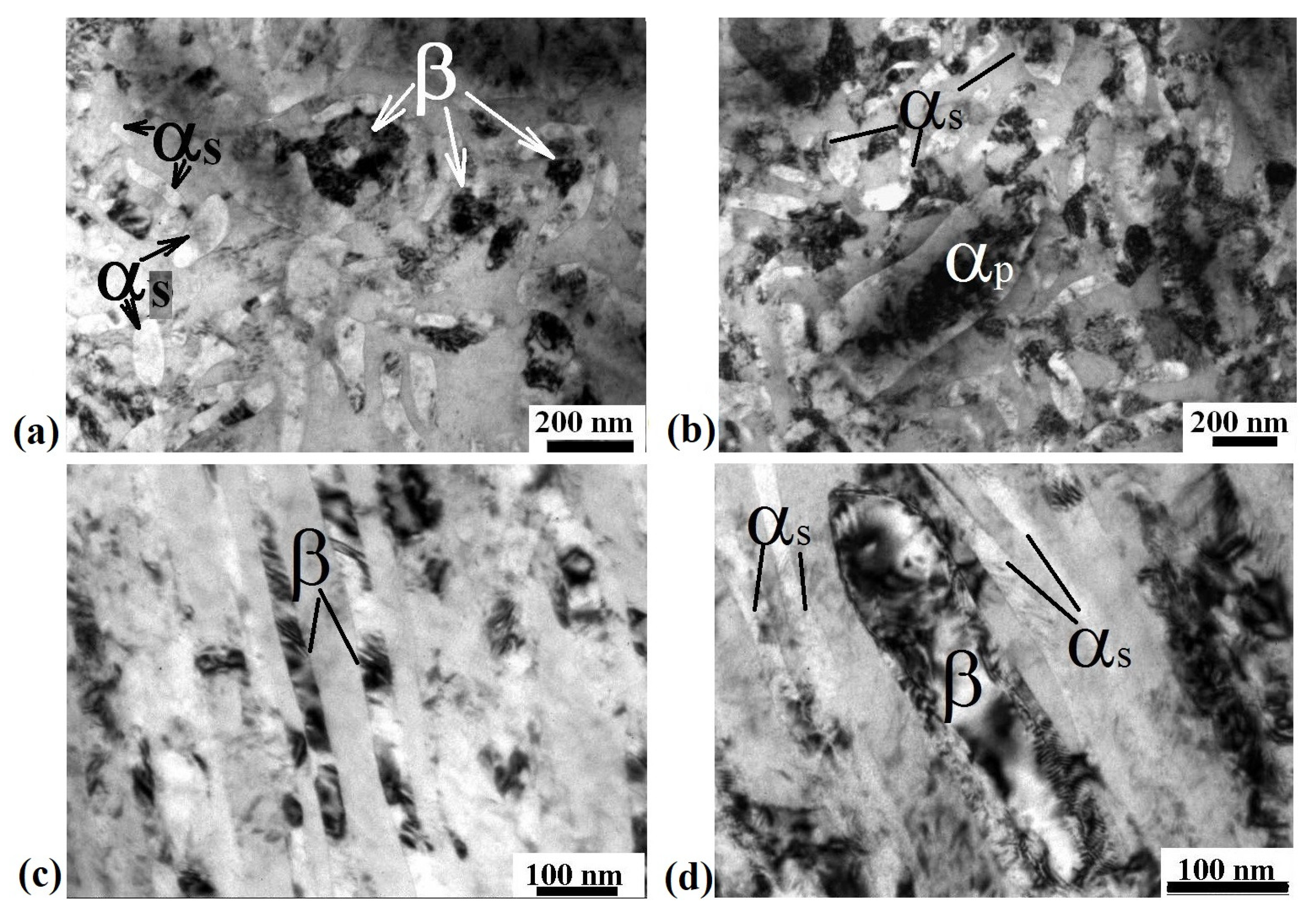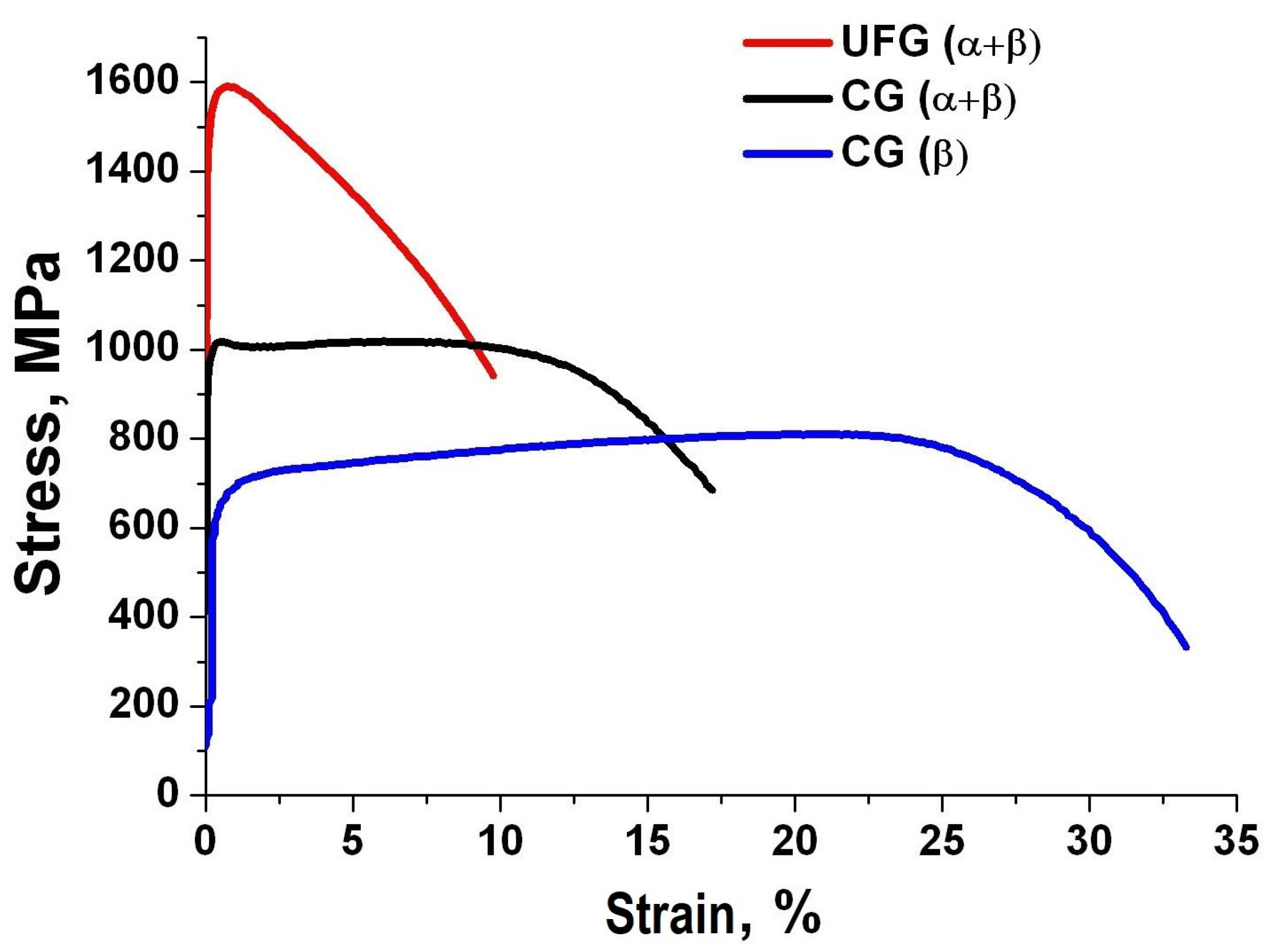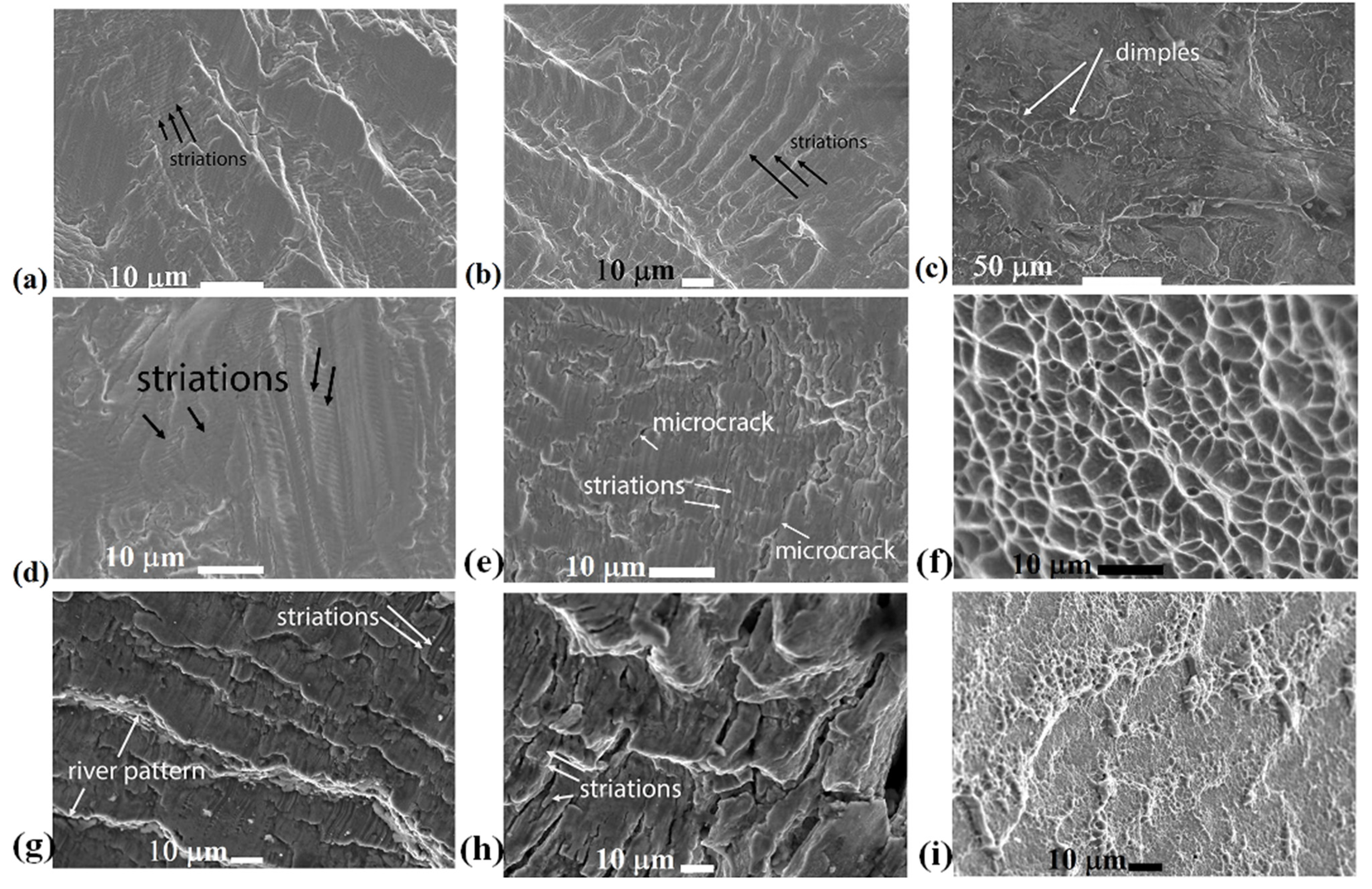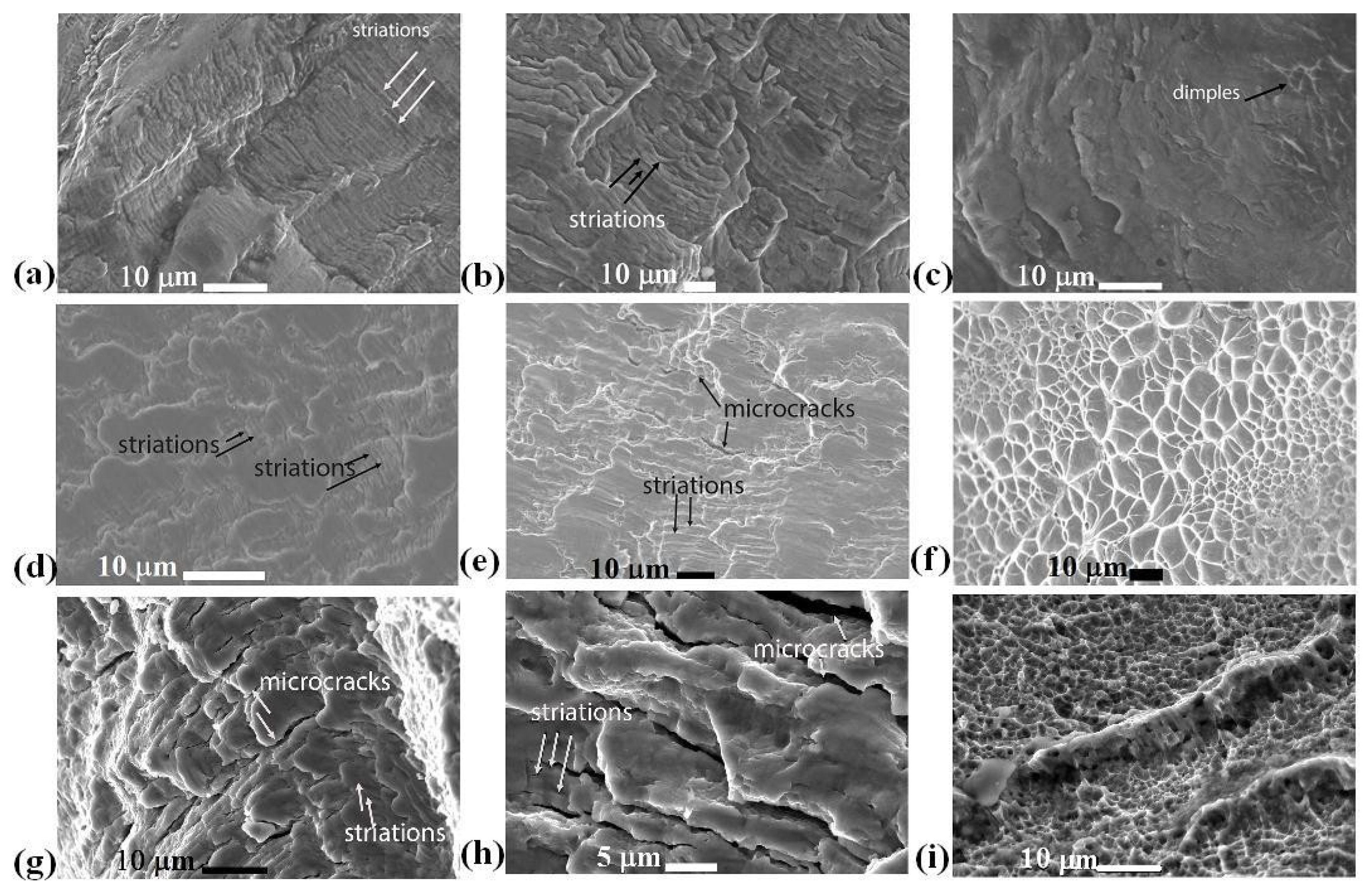Fatigue Behavior and Fracture Features of Ti-15Mo Alloy in β-, (α + β)-, and Ultrafine-Grained Two-Phase States
Abstract
1. Introduction
2. Materials and Methods
3. Results and Discussion
3.1. Investigation of Microstructure and Mechanical Properties
3.2. Fractographic Analysis of Fracture Surface
3.2.1. Fractographic Analysis of Fractures of Samples with Fatigue Life N < 104
3.2.2. Fractographic Analysis of Fractures of Samples with a Fatigue Life N ≈ 3 × 106
4. Conclusions
- The best values of ultimate tensile strength (1590 MPa) and fatigue endurance limit (710 MPa) were obtained in the alloy with two-phase (α + β)-UFG structure due to the significant size reduction in β-grains, i.e., to 150 nm, grains of αp-phase to 480 nm, and the precipitation of particles of the secondary αs-phase with a size of 30 nm and a volume fraction of 37% during TMT.
- The UFG (α + β) state demonstrated the highest resistance to high-cycle fatigue and was characterized by a larger area of fatigue fracture development in the UFG sample, high relief roughness, and the presence of secondary cracks along fatigue striations, which had a beneficial effect on stress relief at the tip of the main crack.
Author Contributions
Funding
Institutional Review Board Statement
Informed Consent Statement
Data Availability Statement
Conflicts of Interest
References
- Lütjering, G.; Williams, J.C.T. Engineering Materials, Processes; Springer: Berlin/Heidelberg, Germany, 2007. [Google Scholar]
- Niinomi, M.; Nakai, M.; Hieda, J. Development of new metallic alloys for biomedical applications. Acta Biomater. 2012, 8, 3888–3903. [Google Scholar] [CrossRef]
- Geetha, M.; Singh, A.K.; Asokamani, R.; Gogia, A.K. Ti Based Biomaterials, the Ultimate Choice for Orthopaedic Implants—A Review. Progr. Mater. Sci. 2009, 54, 397–425. [Google Scholar] [CrossRef]
- An, J.; Yu, Z.; Duan, H.; Tian, Y.; Chen, Y. Mild Wear and Severe Wear Behavior of Ti-6Al-4V Alloy at Low, Intermediate and High Sliding Speeds. Surf. Topogr. Metrol. Prop. 2021, 9, 035047. [Google Scholar] [CrossRef]
- Ho, W.F.; Ju, C.P.; Lin, J.H.C. Structure and Properties of Cast Binary Ti–Mo Alloys. Biomaterials 1999, 20, 2115–2122. [Google Scholar] [CrossRef] [PubMed]
- Gain, A.K.; Zhang, L.; Quadir, M.Z. Composites Matching the Properties of Human Cortical Bones: The Design of Porous Titanium-Zirconia (Ti-ZrO2) Nanocomposites Using Polymethyl Methacrylate Powders. Mater. Sci. Eng. A 2016, 662, 258–267. [Google Scholar] [CrossRef]
- Zhang, L.-C.; Chen, L.-Y. A Review on Biomedical Titanium Alloys: Recent Progress and Prospect. Adv. Eng. Mater. 2019, 21, 1801215. [Google Scholar] [CrossRef]
- Li, H.F.; Zheng, Y.F. Recent Advances in Bulk Metallic Glasses for Biomedical Applications. Acta Biomater. 2016, 36, 1–20. [Google Scholar] [CrossRef]
- Costa, B.C.; Tokuhara, C.K.; Rocha, L.A.; Oliveira, R.C.; Lisboa-Filho, P.N.; Costa Pessoa, J. Vanadium ionic species from degradation of Ti-6Al-4V metallic implants: In vitro cytotoxicity and speciation evaluation. Mater. Sci. Eng. C 2019, 96, 730–739. [Google Scholar] [CrossRef]
- Cardoso, G.C.; Buzalaf, M.A.R.; Correa, D.R.N.; Grandini, C.R. Effect of Thermomechanical Treatments on Microstructure, Phase Composition, Vickers Microhardness, and Young’s Modulus of Ti-xNb-5Mo Alloys for Biomedical Applications. Metals 2022, 12, 788. [Google Scholar] [CrossRef]
- Nunes, A.; Borborema, S.; Araújo, L.; Malet, L.; Dille, J.; Almeida, L. Influence of thermo-mechanical processing on structure and mechanical properties of a new metastable β Ti–29Nb–2Mo–6Zr alloy with low Young’s modulus. J. Alloys Compd. 2020, 820, 153078. [Google Scholar] [CrossRef]
- Karasevskaya, O.P.; Ivasishin, O.M.; Semiatin, S.L.; Matviychuk, Y.V. Deformation behavior of beta-titanium alloys. Mater. Sci. Eng. A 2003, 354, 121–132. [Google Scholar] [CrossRef]
- Sun, F.; Zhang, J.Y.; Vermaut, P.; Choudhuri, D.; Alam, T.; Mantri, S.A.; Svec, P.; Gloriant, T.; Jacques, P.J.; Banerjee, R.; et al. Strengthening strategy for a ductile metastable β-titanium alloy using low-temperature aging. Mater. Res. Let. 2017, 5, 547–553. [Google Scholar] [CrossRef]
- Cheng, J.; Wang, H.; Li, J.; Gai, J.; Ru, J.; Du, Z.; Fan, J.; Niu, J.; Song, H.; Yu, Z. The Effect of Cold Swaging Deformation on the Microstructures and Mechanical Properties of a Novel Metastable β Type Ti–10Mo–6Zr–4Sn–3Nb Alloy for Biomedical Devices. Front. Mater. 2020, 7, 228. [Google Scholar] [CrossRef]
- Marquardt, B.; Shetty, R. Beta Titanium Alloy Processed for High Strength Orthopedic Applications. J. ASTM Int. 2005, 2, 71–82. [Google Scholar] [CrossRef]
- Cojocaru, V.D.; Șerban, N. Effects of Solution Treating on Microstructural and Mechanical Properties of a Heavily Deformed New Biocompatible Ti–Nb–Zr–Fe Alloy. Metals 2018, 8, 297. [Google Scholar] [CrossRef]
- Ho, W.F. A comparison of tensile properties and corrosion behavior of cast Ti-7,5Mo with c.p, Ti-15Mo and Ti-6Al-4V alloys. J. Alloys Compd. 2008, 464, 580–583. [Google Scholar] [CrossRef]
- ASTM F 2066; Standard Specification for Wrought Titanium-15Molybdenum Alloy for Surgical Implant Applications (UNS R58150). Annual Book of ASTM Standards; ASTM International: West Conshohocken, PA, USA, 2018.
- Jablokov, V.R.; Nutt, M.J.; Richelsoph, M.E.; Freese, H.L. The Application of Ti-15Mo Beta Titanium Alloy in High Strength Structural Orthopaedic Applications; ASTM International: West Conshohocken, PA, USA, 2005; Volume 2. [Google Scholar]
- Bowen, A.W. Strength Enhancement in metastable β-titanium alloy: Ti-15Mo. J. Mater. Sci. 1977, 12, 1355–1360. [Google Scholar] [CrossRef]
- Langdon, T.G. Twenty-five years of ultrafine-grained materials: Achieving exceptional properties through grain refinement. Acta Mater. 2013, 61, 7035–7059. [Google Scholar] [CrossRef]
- Ovid’ko, I.A.; Valiev, R.Z.; Zhu, Y.T. Review on superior strength and enhanced ductility of metallic nanomaterials. Prog. Mater. Sci. 2018, 94, 462–540. [Google Scholar] [CrossRef]
- Valiev, R.Z.; Islamgaliev, R.K.; Alexandrov, I.V. Bulk Nanostructured Materials from Severe Plastic Deformation. Prog. Mater. Sci. 2000, 45, 103–189. [Google Scholar] [CrossRef]
- Bartha, K.; Stráský, J.; Veverková, A.; Barriobero-Vila, P.; Lukáč, F.; Doležal, P.; Sedlák, P.; Polyakova, V.; Semenova, I.; Janeček, M. Effect of the High-Pressure Torsion (HPT) and Subsequent Isothermal Annealing on the Phase Transformation in Biomedical Ti15Mo Alloy. Metals 2019, 9, 1194. [Google Scholar] [CrossRef]
- Jiang, B.; Emura, S.; Tsuchiya, K. Formation of equiaxed α phase in Ti-5Al-5Mo-5V-3Cr alloy deformed by high-pressure torsion. J. Alloys Compd. 2018, 738, 283–291. [Google Scholar] [CrossRef]
- Godoy, D.; Jorge, A.; Kiminami, C.; Bolfarini, C.; Botta, W. Ultrafine-Grained Ti-13Nb-13Zr Alloy Produced by Severe Plastic Deformation. Mater. Res. 2017, 20, 404–410. [Google Scholar] [CrossRef]
- Bartha, K.; Stráský, J.; Barriobero-Vila, P.; Šmilauerová, J.; Doležal, P.; Veselý, J.; Semenova, I.; Polyakova, V.; Janeček, M. In-situ investigation of phase transformations in ultra-fine grained Ti15Mo alloy. J. Alloys Compd. 2021, 867, 159027. [Google Scholar] [CrossRef]
- Naydenkin, E.V.; Mishin, I.P.; Ratochka, I.V.; Oborin, V.A.; Bannikov, M.V.; Bilalov, D.A.; Naydenkin, K.E. Fatigue and fracture behavior of ultrafine-grained near β titanium alloy produced by radial shear rolling and subsequent aging. Mater. Sci. Eng. A 2021, 810, 140968. [Google Scholar] [CrossRef]
- Sheremetyev, V.; Kudryashova, A.; Dubinskiy, S.; Galkin, S.; Prokoshkin, S.; Brailovski, V. Structure and functional properties of metastable beta Ti-18Zr-14Nb (at.%) alloy for biomedical applications subjected to radial shear rolling and thermomechanical treatment. J. Alloys Compd. 2018, 737, 678–683. [Google Scholar] [CrossRef]
- Mairambekova, A.M.; Eroshenko, A.Y.; Oborin, V.A.; Bannikov, M.V.; Chebodaeva, V.V.; Terekhina, A.I.; Naimark, O.B.; Dmitriev, A.I.; Sharkeev, Y.P. Characteristic Features of Ultrafine-Grained Ti-45 wt.% Nb Alloy under High Cycle Fatigue. Materials 2021, 14, 5365. [Google Scholar] [CrossRef]
- Semenova, I.P.; Modina, Y.M.; Stotskiy, A.G.; Polyakov, A.V.; Pesin, M.V. Fatigue Properties of Ti Alloys with an Ultrafine Grained Structure: Challenges and Achievements. Metals 2022, 12, 312. [Google Scholar] [CrossRef]
- Estrin, Y.; Vinogradov, A. Fatigue behaviour of light alloys with ultrafine grain structure produced by severe plastic deformation: An overview. Int. J. Fatigue 2010, 32, 898–907. [Google Scholar] [CrossRef]
- Vinogradov, A.Y.; Stolyarov, V.V.; Hashimoto, S.; Valiev, R.Z. Cyclic behavior of ultrafine-grain titanium produced by severe plastic deformation. Mater. Sci. Eng. A 2001, 318, 163–173. [Google Scholar] [CrossRef]
- Saitova, L.; Hoppel, H.; Goken, M.; Semenova, I.; Valiev, R. Cyclic deformation behavior and fatigue lives of ultrafine-grained Ti-6AL-4V ELI alloy for medical use. Int. J. Fatigue 2009, 31, 322–331. [Google Scholar] [CrossRef]
- Vinogradov, A. Fatigue limit and crack growth in ultra-fine grain metals produced by severe plastic deformation. J. Mater. Sci. 2006, 42, 1797–1808. [Google Scholar] [CrossRef]
- Gatina, S.A.; Polyakova, V.V.; Polyakov, A.V.; Semenova, I.P. Microstructure and Mechanical Properties of β-Titanium Ti-15Mo Alloy Produced by Combined Processing including ECAP-Conform and Drawing. Materials 2022, 15, 8666. [Google Scholar] [CrossRef] [PubMed]
- ATI Ti15Mo Technical Data Sheet. 2014. Available online: https://www.atimaterials.com/Products/Documents/datasheets/titanium/alloyed/ati_15Mo_Titanium_Alloy_en_v4%20final.pdf (accessed on 23 April 2014).
- Raab, G.I.; Gunderov, D.V.; Valiev, R.Z.; Baushev, N.G. Method for Deformation Processing of a Metal Workpiece in the Form of a Bar. RF Patent No. 2417857, 5 October 2011. [Google Scholar]
- Scardi, P.; Lutterotti, L.; Di Maggio, R. Size-Strain and quantitative analysis by the Rietveld method. Adv. X-ray Anal. 1991, 35, 69–75. [Google Scholar] [CrossRef]
- Gleiter, H. Nanostructured Materials: Basic Concepts and Microstructure. Acta Mater. 2000, 48, 1–29. [Google Scholar] [CrossRef]
- Ivasishin, O.M.; Markovsky, P.E.; Matviychuk, Y.V.; Semiatin, S.L. Precipitation and recrystallization behavior of beta titanium alloys during continuous heat treatment. Metall. Mater. Trans. A 2003, 34, 147–158. [Google Scholar] [CrossRef]
- Terent’ev, V.F. Fatigue Strength of Metals and Alloys; Intermet Engineering: Moscow, Russia, 2002; p. 288. [Google Scholar]
- Zherebtsov, S.; Salishchev, G.; Galeyev, R.; Maekawa, K. Mechanical Properties of Ti–6Al–4V Titanium Alloy with Submicrocrystalline Structure Produced by Severe Plastic Deformation. Mater. Trans. 2005, 46, 2020–2025. [Google Scholar] [CrossRef]
- Zhang, J.; Jiang, Y. Fatigue of polycrystalline copper with different grain sizes and texture. Int. J. Plast. 2006, 22, 536–556. [Google Scholar] [CrossRef]











| Ti | Mo | O | Fe | C | N |
|---|---|---|---|---|---|
| balance | 15.2 | 0.16 | 0.02 | 0.008 | 0.10 |
| Alloy | σuts, MPa | σ−1, MPa | σ−1/σuts |
|---|---|---|---|
| (β)-Ti-15Mo CG | 800 | 410 | 0.51 |
| (α+β)-Ti-15Mo CG | 1017 | 500 | 0.49 |
| (α+β)-Ti-15Mo UFG | 1590 | 710 | 0.45 |
| Ti-6Al-4V ELI CG [43] | 960 | 580 | 0.6 |
| Ti-6Al-4V ELI UFG [43] | 1300 | 690 | 0.53 |
| Ti Grade 4 CG [33] | 460 | 238 | 0.52 |
| Ti Grade 4 UFG [33] | 810 | 380 | 0.48 |
| Fatigue Life | N < 104 | N ≈ 3 × 106 | ||||||
|---|---|---|---|---|---|---|---|---|
| State of Alloy | # | σ−1, MPa | I | II | # | σ−1, MPa | I | II |
| CG (β) | 1 | 670 | 1.8 ± 0.9 | 4.5 ± 0.1 | 4 | 430 | 0.7 ± 0.05 | 2.4 ± 0.1 |
| CG (α+β) | 2 | 695 | 1.2 ± 0.1 | 1.8 ± 0.06 | 5 | 545 | 0.6 ± 0.05 | 1.2 ± 0.1 |
| UFG (α+β) | 3 | 825 | 2 ± 0.2 | 4 ± 0.2 | 6 | 720 | 1 ± 0.15 | 1.4 ± 0.2 |
Disclaimer/Publisher’s Note: The statements, opinions and data contained in all publications are solely those of the individual author(s) and contributor(s) and not of MDPI and/or the editor(s). MDPI and/or the editor(s) disclaim responsibility for any injury to people or property resulting from any ideas, methods, instructions or products referred to in the content. |
© 2023 by the authors. Licensee MDPI, Basel, Switzerland. This article is an open access article distributed under the terms and conditions of the Creative Commons Attribution (CC BY) license (https://creativecommons.org/licenses/by/4.0/).
Share and Cite
Gatina, S.A.; Polyakova, V.V.; Modina, I.M.; Semenova, I.P. Fatigue Behavior and Fracture Features of Ti-15Mo Alloy in β-, (α + β)-, and Ultrafine-Grained Two-Phase States. Metals 2023, 13, 580. https://doi.org/10.3390/met13030580
Gatina SA, Polyakova VV, Modina IM, Semenova IP. Fatigue Behavior and Fracture Features of Ti-15Mo Alloy in β-, (α + β)-, and Ultrafine-Grained Two-Phase States. Metals. 2023; 13(3):580. https://doi.org/10.3390/met13030580
Chicago/Turabian StyleGatina, Svetlana A., Veronika V. Polyakova, Iuliia Mikhailovna Modina, and Irina P. Semenova. 2023. "Fatigue Behavior and Fracture Features of Ti-15Mo Alloy in β-, (α + β)-, and Ultrafine-Grained Two-Phase States" Metals 13, no. 3: 580. https://doi.org/10.3390/met13030580
APA StyleGatina, S. A., Polyakova, V. V., Modina, I. M., & Semenova, I. P. (2023). Fatigue Behavior and Fracture Features of Ti-15Mo Alloy in β-, (α + β)-, and Ultrafine-Grained Two-Phase States. Metals, 13(3), 580. https://doi.org/10.3390/met13030580








